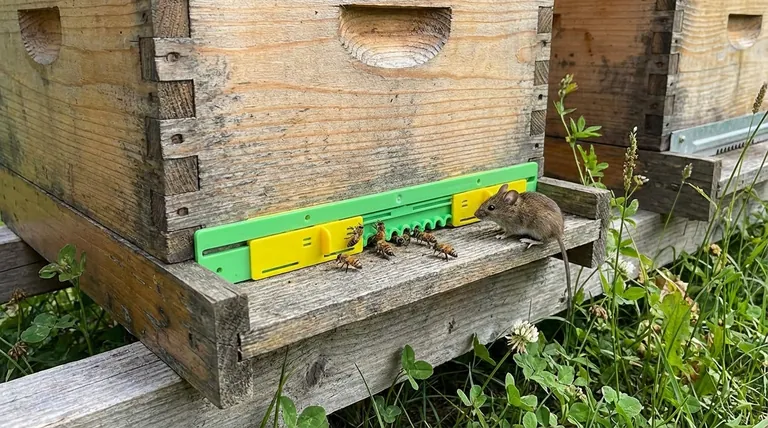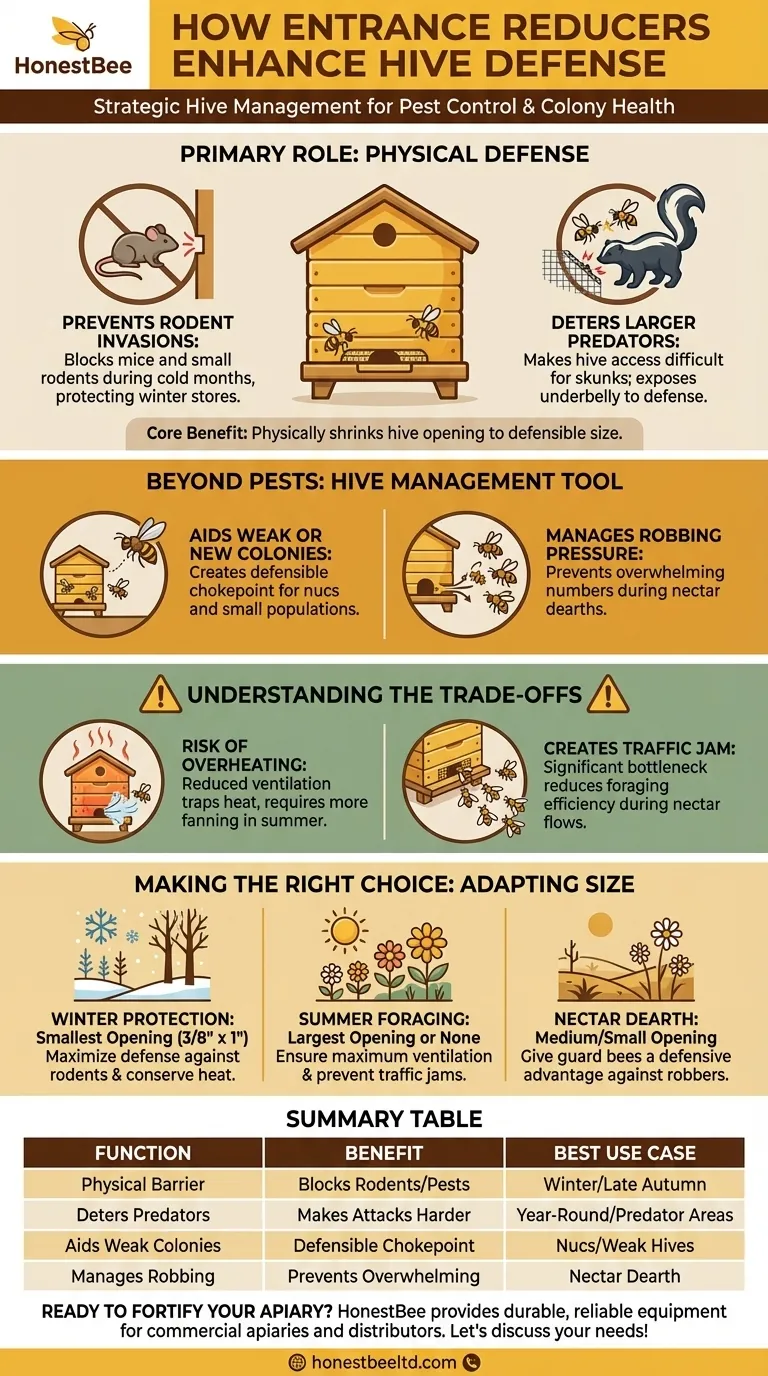At its core, an entrance reducer helps with pest control by physically shrinking the hive's opening to a size that honey bees can easily defend. This simple modification makes it impossible for larger pests, especially rodents like mice and chipmunks, to invade the colony. It is a fundamental tool for protecting a hive during its most vulnerable periods.
The true purpose of an entrance reducer isn't just to block pests, but to manage the hive's "front door" strategically. It's about balancing defensibility against the colony's need for ventilation and foraging traffic, adapting the entrance size to the season and the strength of the hive.

The Primary Role: Physical Defense
The most immediate benefit of an entrance reducer is creating a physical barrier. A standard Langstroth hive entrance is a wide-open invitation to creatures much larger than a honey bee.
Preventing Rodent Invasions
During late autumn and winter, mice and other rodents seek shelter and a reliable food source. A beehive offers both warmth from the clustering bees and energy-rich honey.
Without a reducer, a mouse can easily enter, build a nest, destroy comb, and consume vital winter stores. The constant disturbance and contamination cause immense stress, often leading to the colony's collapse. An entrance reducer with an opening of 3/8 inch or less makes it physically impossible for a mouse to get inside.
Deterring Larger Predators
Predators like skunks attack hives by scratching at the entrance, enticing guard bees to come out so they can be eaten. A standard wooden reducer makes this process more difficult for the predator.
More advanced designs, such as angled wire mesh reducers, are even more effective. This design forces the skunk to get its nose close to the opening, exposing its vulnerable, less-furred underbelly to the bees' stings, making the hive a much less appealing target.
Beyond Pests: A Tool for Hive Management
While blocking large pests is its most obvious function, an entrance reducer is a multi-purpose tool that helps manage the overall security and health of the colony.
Aiding a Weak or New Colony
A small, newly installed "nuc" or a weaker hive has a smaller population of guard bees. A full-sized entrance is simply too large for them to patrol effectively.
By reducing the entrance, you give a small colony a defensible chokepoint. This allows a handful of guard bees to successfully fend off threats that would otherwise overwhelm them, including robbing bees from other hives.
Managing Robbing Pressure
"Robbing" is when bees from a strong, nearby hive discover a weaker hive and systematically steal its honey stores. This is a common occurrence, especially during a nectar dearth when natural food sources are scarce.
A reduced entrance creates a bottleneck that the defending colony can manage. It prevents a flood of robber bees from overwhelming the guards, giving the hive a fighting chance to protect its resources.
Understanding the Trade-offs
Using an entrance reducer is not a "set it and forget it" solution. Its benefits are situational, and using it incorrectly can harm the colony.
The Risk of Overheating
The primary drawback is reduced ventilation. In the heat of summer, a restricted entrance can trap hot, humid air inside the hive, forcing the bees to work harder fanning their wings just to regulate the temperature.
Creating a "Traffic Jam"
During a strong nectar flow, tens of thousands of forager bees are flying in and out of the hive. A small entrance creates a significant bottleneck, causing a "traffic jam" that reduces foraging efficiency and can limit your honey harvest.
Knowing When to Adjust
The key is to adapt the entrance size to the season and the colony's strength. A small opening is critical in winter but can be detrimental in the peak of summer. Strong, populous hives typically need no reducer at all during the main foraging season.
Making the Right Choice for Your Hive
The goal is to match the entrance size to your colony's immediate needs, which change throughout the year.
- If your primary focus is overwintering a colony or protecting a new hive: Use the smallest opening (typically 3/8" x 1") to maximize defense against rodents and robbers while helping to conserve heat.
- If your primary focus is maximizing honey production in a strong hive during summer: Remove the reducer completely or use its largest setting to ensure maximum ventilation and prevent a forager traffic jam.
- If your primary focus is preventing robbing during a nectar dearth: Use a medium or small opening, depending on the hive's strength, to give your guard bees a defensive advantage.
Proactive management of the hive entrance is a fundamental skill that directly translates to a healthier, more resilient colony.
Summary Table:
| Function | Benefit | Best Use Case |
|---|---|---|
| Physical Barrier | Blocks rodents and large pests from entering the hive. | Winter protection, late autumn. |
| Deters Predators | Makes it harder for skunks to attack; exposes them to bee stings. | Year-round, especially in areas with predator pressure. |
| Aids Weak Colonies | Creates a defensible chokepoint for a small number of guard bees. | New nucs, package bees, or weakened hives. |
| Manages Robbing | Prevents overwhelming numbers of robber bees from entering. | During a nectar dearth, or when hive strength varies. |
Ready to fortify your apiary? Proper equipment is the foundation of successful beekeeping. At HONESTBEE, we supply commercial apiaries and beekeeping equipment distributors with the durable, reliable supplies needed to protect their investments. From entrance reducers to full hive setups, our wholesale-focused operations ensure you get the quality gear your bees deserve. Let's discuss your needs—contact our team today to get started.
Visual Guide

Related Products
- Multi-Functional Sliding Hive Entrance for Beekeeping
- Multi-Functional Rotary Hive Entrance Disc for Beekeeping
- Beehive Entrance Discs Plastic Bee Entrance Disc for Bee Hives
- Professional Engraved Round Hive Number Tags for Beekeeping
- Professional Hive Front Entrance Bee Feeder
People Also Ask
- What are the different entrance sizes for an 8 or 10-frame Langstroth hive? A Guide to Seasonal Management
- What are some alternative strategies to using entrance reducers? Empower Your Bees for Natural Hive Defense
- How does entrance configuration vary seasonally for beekeepers? A Guide to Year-Round Hive Health
- What additional functions do hive entrances serve? A Key to Colony Health, Security, and Productivity
- How can a Langstroth hive entrance be adjusted? Mimic Natural Bee Preferences for a Healthier Hive



















